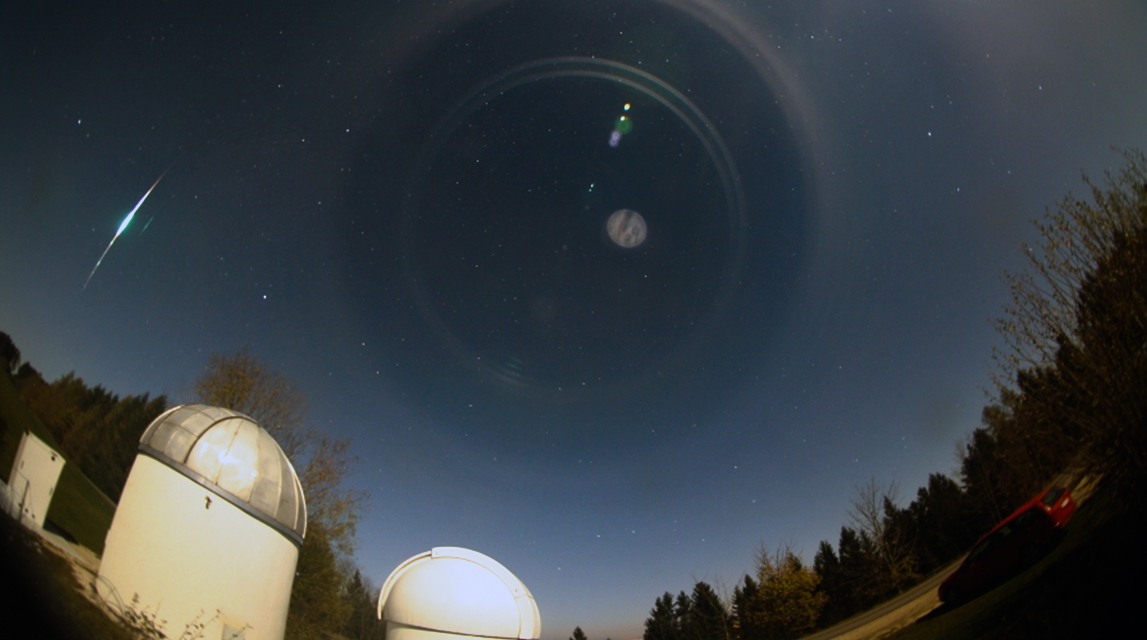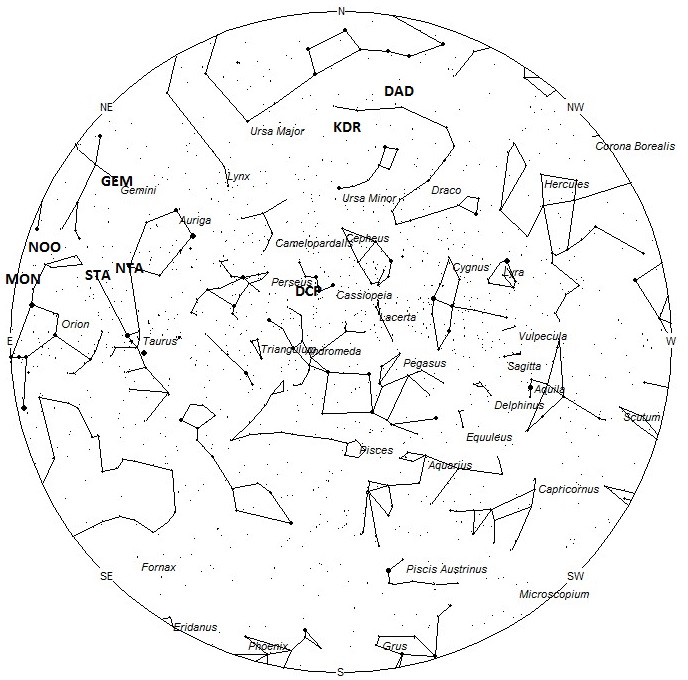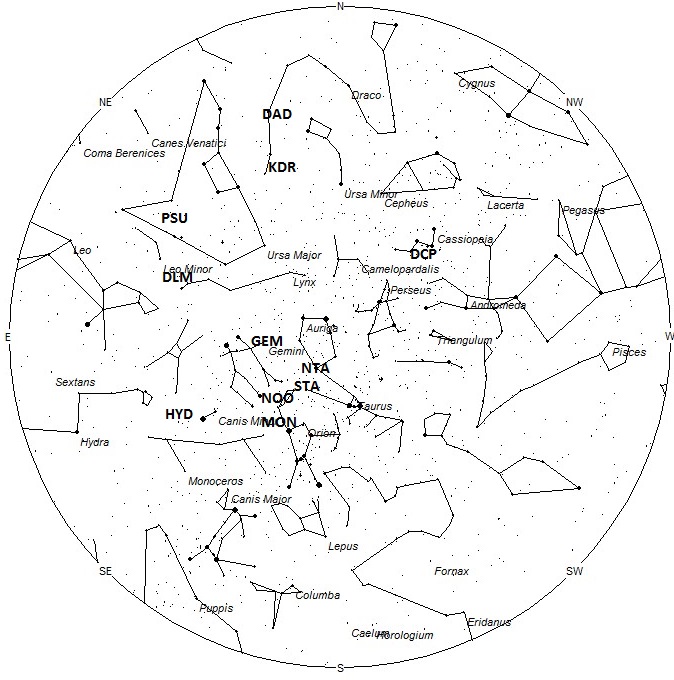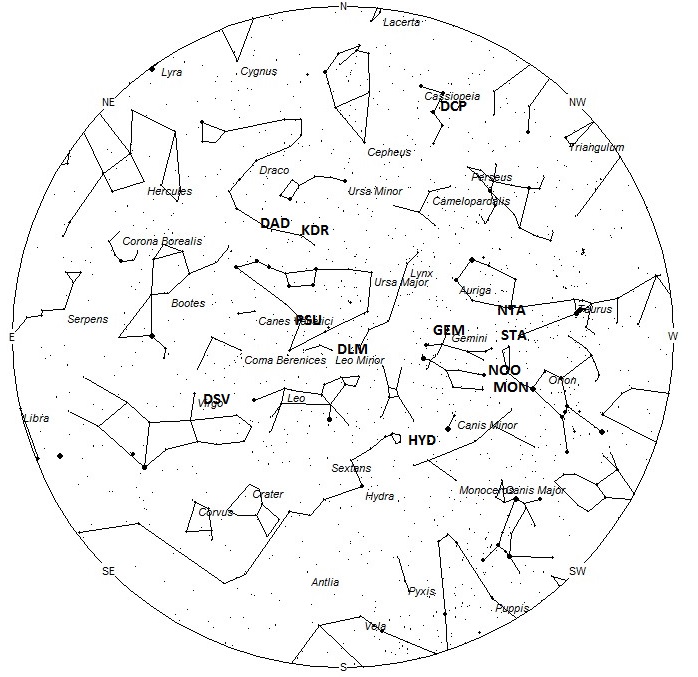
During this period the moon will reach its full phase on Sunday December 3rd. At that time the moon will lie opposite the sun and will lie above the horizon all night long as seen from the northern hemisphere. Later in this period the moon will rise during the late evening hours allowing a few hours of observing under dark skies between dusk and moon rise. The estimated total hourly meteor rates for evening observers this week is near 3 as seen from mid-northern latitudes (45N) and 2 as seen from tropical southern locations (25S). For morning observers the estimated total hourly rates should be near 15 as seen from mid-northern latitudes and 10 from the southern tropics. The actual rates will also depend on factors such as personal light and motion perception, local weather conditions, alertness and experience in watching meteor activity. Meteor rates are reduced during this period due to moonlight. Note that the hourly rates listed below are estimates as viewed from dark sky sites away from urban light sources. Observers viewing from urban areas will see less activity as only the brighter meteors will be visible from such locations.
The radiant (the area of the sky where meteors appear to shoot from) positions and rates listed below are exact for Saturday night/Sunday morning December 2/3. These positions do not change greatly day to day so the listed coordinates may be used during this entire period. Most star atlases (available at science stores and planetariums) will provide maps with grid lines of the celestial coordinates so that you may find out exactly where these positions are located in the sky. A planisphere or computer planetarium program is also useful in showing the sky at any time of night on any date of the year. Activity from each radiant is best seen when it is positioned highest in the sky, either due north or south along the meridian, depending on your latitude. It must be remembered that meteor activity is rarely seen at the radiant position. Rather they shoot outwards from the radiant so it is best to center your field of view so that the radiant lies near the edge and not the center. Viewing there will allow you to easily trace the path of each meteor back to the radiant (if it is a shower member) or in another direction if it is a sporadic. Meteor activity is not seen from radiants that are located far below the horizon. The positions below are listed in a west to east manner in order of right ascension (celestial longitude). The positions listed first are located further west therefore are accessible earlier in the night while those listed further down the list rise later in the night.
These sources of meteoric activity are expected to be active this week.
Details on each source will continue next week when moonlight is more favorable for viewing meteor activity.
| SHOWER | DATE OF MAXIMUM ACTIVITY | CELESTIAL POSITION | ENTRY VELOCITY | CULMINATION | HOURLY RATE | CLASS |
| RA (RA in Deg.) DEC | Km/Sec | Local Standard Time | North-South | |||
| December Phoenicids (PHO) | Dec 05 | 01:00 (015) -53 | 12 | 20:00 | <1 – <1 | III |
| December phi Cassiopeiids (DPC) | Dec 04 | 01:12 (018) +57 | 17 | 20:00 | <1 – <1 | IV |
| Northern Taurids (NTA) | Nov 02 | 05:24 (081) +29 | 28 | 00:00 | 2 – 1 | II |
| Southern Taurids (STA) | Oct 29-Nov 03 | 05:32 (083) +22 | 27 | 00:00 | 1 – <1 | II |
| Monocerotids (MON) | Dec 13 | 06:12 (093) +09 | 41 | 01:00 | 1 – 1 | II |
| November Orionids (NOO) | Nov 29 | 06:24 (096) +16 | 43 | 01:00 | 2 – 1 | II |
| Geminids (GEM) | Dec 14 | 06:52 (103) +34 | 34 | 02:00 | 1 – <1 | I |
| Puppid/Velids (PUP) | Dec 07 | 08:00 (120) -45 | 40 | 03:00 | <1 – 1 | II |
| sigma Hydrids (HYD) | Dec 06 & Dec 18 | 08:08 (122) +03 | 61 | 03:00 | 2 – 2 | II |
| December Leonis Minorids (DLM) | Dec 21 | 09:32 (143) +37 | 63 | 04:00 | <1 – <1 | II |
| psi Ursa Majorids (PSU) | Dec 05 | 10:56 (164) +44 | 62 | 05:00 | <1 – <1 | IV |
| December kappa Draconids (DKD) | Dec 04 | 12:20 (185) +73 | 44 | 07:00 | <1 – <1 | IV |
| December sigma Virginids (DSV) | Dec 13 | 12:44 (191) +10 | 66 | 07:00 | <1 – <1 | IV |
| December alpha Draconids (DAD) | Dec 04 | 13:24 (201) +61 | 44 | 08:00 | <1 – <1 | IV |
 American Meteor Society
American Meteor Society



At 3:13am I saw the most AMAZING meteor/fireball/shooting star, it was almost life changing. It looked like it was so close. The colors were mesmerizing. So insane. I was so lucky to just happen to walk outside to investigate a skunk smell in my back yard. Wow!
On December 2 around 3:10 am we saw a spectacular large meteor that was a bright green and low in the sky. We were on our way to the airport for an early morning flight and are fortunate to have seen such a beautiful sight, one which will not soon be forgotten.
On December 26 just before 6:00 pm we saw the large meteor in the northern sky that has been reported by so many others. Two beautiful meteors in less than 30 days. Lucky we are indeed.
I saw a fireball in the sky on 12/3/17 at about 7:35pm.
On December 5th at around 6:30am I noticed 5 meteors in the Eastern part of the sky. Located in Stockton, CA.
Witnessed December 8th 9:40 pm 2017,meteor in Quinlan/ wills point Texas
So blessed to have seen this fireball glide through the dark sky!
December 8 in the early morning at 12:45 driving down the 401 before Cardinal Ontario heading west, there was a meteor falling really close, bright fireball, towards the south, then it exploded like a firework! Is this normal? I always see them just burn out.
Karen and All,
These exploding fireballs are known as bolides. As you said, most fireballs simply burn out but on occasion a bright one will appear to burst before disappearing.
Robert Lunsford